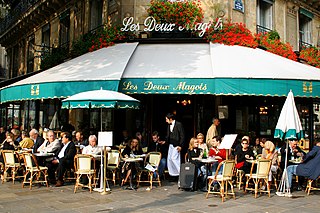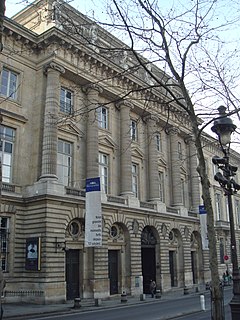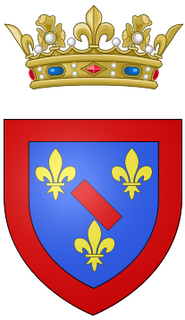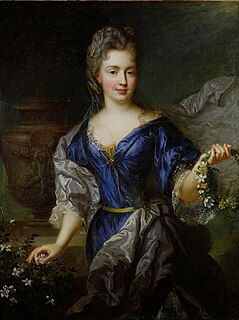
The 6th arrondissement of Paris is one of the 20 arrondissements of the capital city of France. In spoken French, this arrondissement is referred to as sixième.
The Most Serene House of Bourbon-Condé named after Condé-en-Brie, now in the Aisne département, is a French princely house and a cadet branch of the House of Bourbon. The name of the house was derived from the title of Prince of Condé that was originally assumed around 1557 by the French Protestant leader, Louis de Bourbon (1530–1569), uncle of King Henry IV of France, and borne by his male-line descendants.

The Monnaie de Paris is a government-owned institution responsible for producing France's euro coins. Founded in 864 AD, it is the world's oldest continuously-running minting institution operating from two sites, one in Paris and one in Pessac. Administratively speaking, the "Direction of Coins and Medals", the national mint is an administration of the French government charged with issuing coins as well as producing medals and other similar items. Many ancient coins are housed in the collections maintained there. Though in the Middle Ages there were numerous other mints in provincial cities officially issuing legitimate French coinage struck in the name of the ruler, the Monnaie de Paris has always been the prime issuer.

François Louis de Bourbon, le Grand Conti, was Prince de Conti, succeeding his brother, Louis Armand de Bourbon, in 1685. Until this date, he used the title of Prince of La Roche-sur-Yon. He was son of Armand de Bourbon, Prince of Conti and Anne Marie Martinozzi, daughter of Girolamo Martinozzi and niece of Cardinal Mazarin, through her mother. He was proclaimed as the King of Poland in 1697. He is the most famous member of the Conti family, a cadet branch of the Princes of Condé. As a member of the reigning House of Bourbon, he was a prince du sang.

Louis Armand de Bourbon was Prince of Conti from 1666 to his death, succeeding his father, Armand de Bourbon. His mother was Anne Marie Martinozzi, the daughter of Girolamo Martinozzi and Laura Margherita Mazzarini, elder sister of Cardinal Mazarin. As a member of the reigning House of Bourbon, he was a Prince du Sang. He was a son-in-law of King Louis XIV of France, who was his namesake.

The title of Prince of Conti was a French noble title, assumed by a cadet branch of the princely house of Bourbon-Condé.

Anne Marie Martinozzi, Princess of Conti was a French aristocrat and court official. She was a niece of King Louis XIV of France's chief minister Cardinal Mazarin, and the wife of Armand de Bourbon, Prince of Conti. She became the mother of the libertine François Louis, Prince of Conti, le Grand Conti. Her marriage to the Prince of Conti made her a princesse du Sang. She served as Surintendante de la Maison de la Reine for the queen dowager, Anne of Austria, between 1657 and 1666.

Louis Armand de Bourbon was Prince of Conti, from 1709 to his death, succeeding his father, François Louis de Bourbon. As a member of the reigning House of Bourbon, he was a Prince du Sang. His mother was Marie Thérèse de Bourbon, daughter of Henri Jules, Prince of Condé and granddaughter of Louis de Bourbon, le Grand Condé. He was nominated as the Prince of Orange by King Louis XIV of France in 1712.

Marie Anne de Bourbon, Légitimée de France was the eldest legitimised daughter of King Louis XIV of France and his mistress Louise de La Vallière. At the age of thirteen, she was married to Louis Armand de Bourbon, Prince of Conti and as such was the Princess of Conti by marriage. Her father's favourite daughter, Marie Anne was widowed in 1685 aged 19. She never married again and had no children. Following her mother's retirement to a convent, Marie Anne continued to reside at her father's court and was later her mother's heiress. She later became the Duchess of La Vallière in her own right.

Louise Françoise de Bourbon, Légitimée de France was the eldest surviving legitimised daughter of Louis XIV of France and his maîtresse-en-titre, Madame de Montespan. She was said to have been named after her godmother, Louise de La Vallière, the woman that her mother had replaced as the king's mistress. Prior to her marriage, she was known at court as Mademoiselle de Nantes.

Louise Élisabeth de Bourbon was a daughter of Louis III de Bourbon, Prince of Condé, and his wife, Louise Françoise de Bourbon, légitimée de France, a legitimised daughter of King Louis XIV of France and his famous mistress, Madame de Montespan.

Marie Thérèse de Bourbon was the titular Queen consort of Poland in 1697. She was the daughter of the Prince of Condé. As a member of France's reigning House of Bourbon, she was a princesse du sang.

Marie Anne de Bourbon was the daughter of the Prince of Condé and a Bavarian princess by birth. As a member of the reigning House of Bourbon, she was a Princesse du Sang. She was the duchesse de Vendôme by marriage. She was also the Duchess of Étampes in her own right.

The Hôtel des Monnaies is an 18th-century building located at 11 Quai de Conti in the 6th arrondissement of Paris, which has housed the Monnaie de Paris since its construction. It is considered a prime example of pre-Revolutionary French Neoclassical architecture.

Louise Adélaïde de Bourbon was a French princess of the Blood and member of the courts of Louis XIV and his successor Louis XV of France. She never married, but she had many illegitimate children.

The Hôtel de Brienne is an 18th-century French townhouse at 14 rue Saint-Dominique in the 7th arrondissement of Paris. It was built in 1724 to the designs of the architect François Debias-Aubry for François Duret, a real estate entrepreneur, who was also president of the Grand Conseil. Duret sold it to Françoise de Mailly, Marquis de La Vrillière, who allowed her son, Louis Phélypeaux, Count of Saint-Florentin to stay on the upper floor. The marquess sold it to Louise-Elisabeth de Bourbon, Princesse de Conti in 1733, and it became known as the the Hôtel de Conti. It was sold to Louis-Marie-Athanase of Loménie, Count of Brienne in 1776, when it acquired its current name. Laetizia Bonaparte, Napoleon's mother, lived here during the First French Empire, and Charles de Gaulle used it as his office at various times during the Second World War. It is currently occupied by the French Ministry of the Armed Forces.

Anne Marie de Bourbon was the daughter of the Prince of Condé and of a Bavarian princess. As a member of the reigning House of Bourbon, she was a Princesse du Sang. She never married and died of lung disease.

Hôtel de Guénégaud is a 17th-century hôtel particulier, or large townhouse, in Paris.

The Hôtel de Nevers, later the Hôtel de Guénégaud, then the Hôtel de Conti, was a French aristocratic townhouse, which was located on the quai de Nevers, just east of the former Tour de Nesle on the site of the present day Hôtel des Monnaies in the 6th arrondissement of Paris. Construction began in 1580 to the designs of an unknown architect for Louis Gonzaga, Duke of Nevers, although it was never completed as intended. The hôtel was demolished sometime between 1753 and 1771.

The Hôtel du Plessis-Guénégaud was a French aristocratic townhouse, built 1630–1632 for the financier Louis Le Barbier to the designs of architect Clément Métezeau and located at what is now 13 Quai Malaquais in the 6th arrondissement of Paris. It was destroyed to make way for the Duban building (1832) of the École des Beaux-Arts. Its names include Hôtel de Brienne, Hôtel de Conti (1660–1670), Hôtel du Plessis-Guénégaud, Hôtel de Créquy (1680–1733), and Hôtel Mazarin.

















